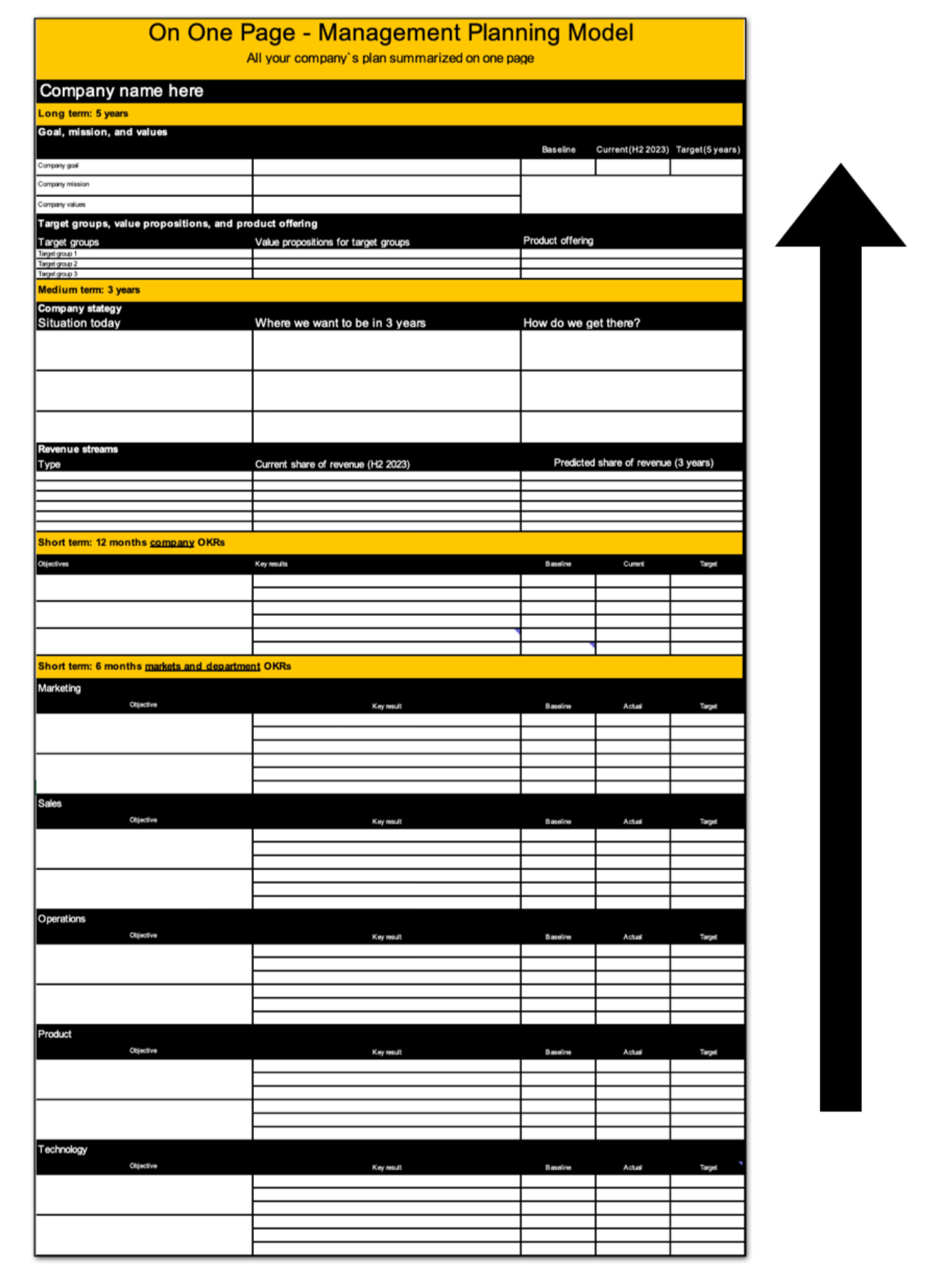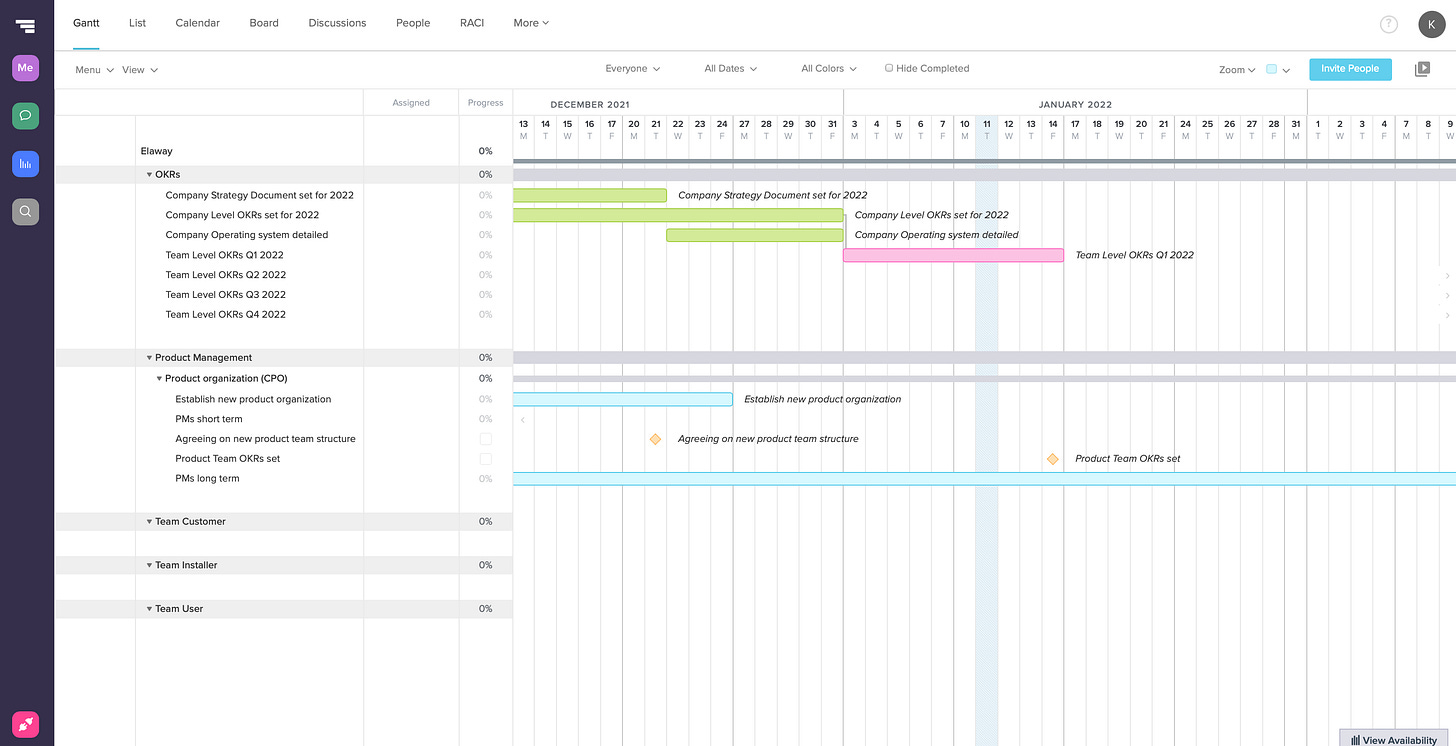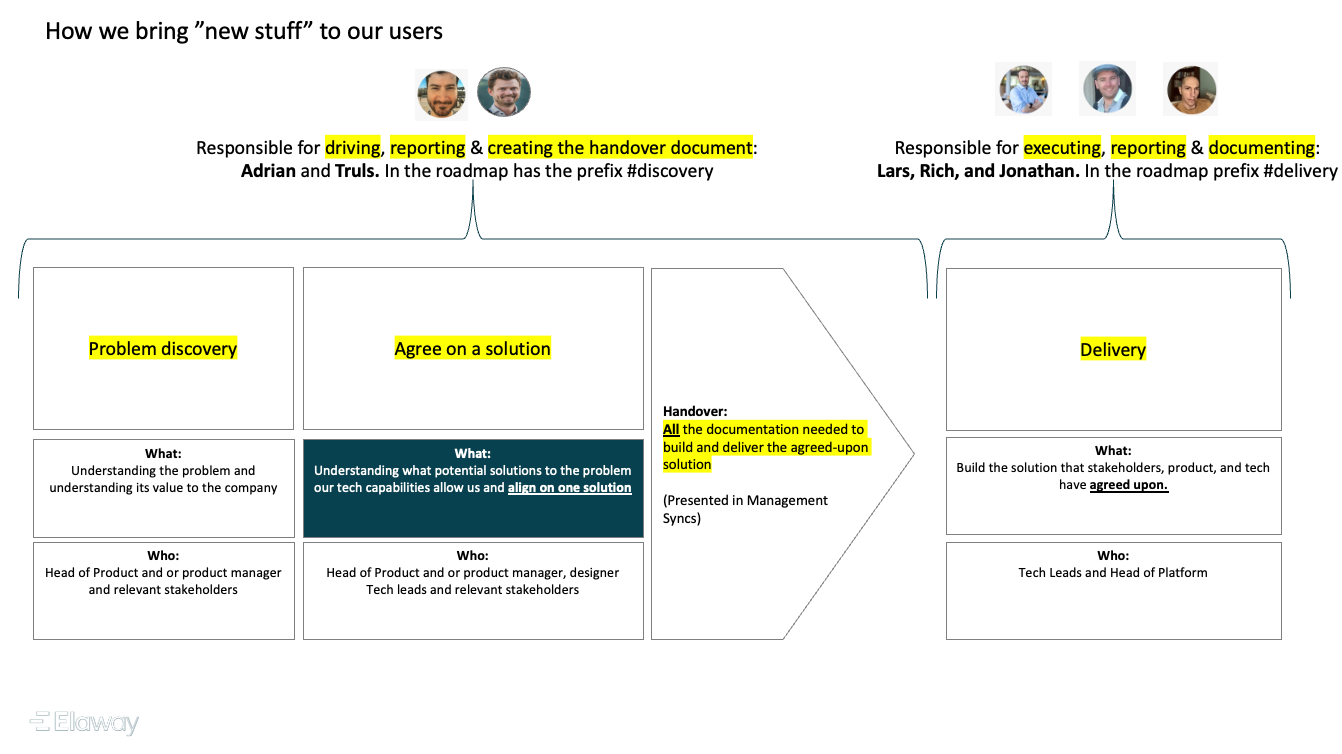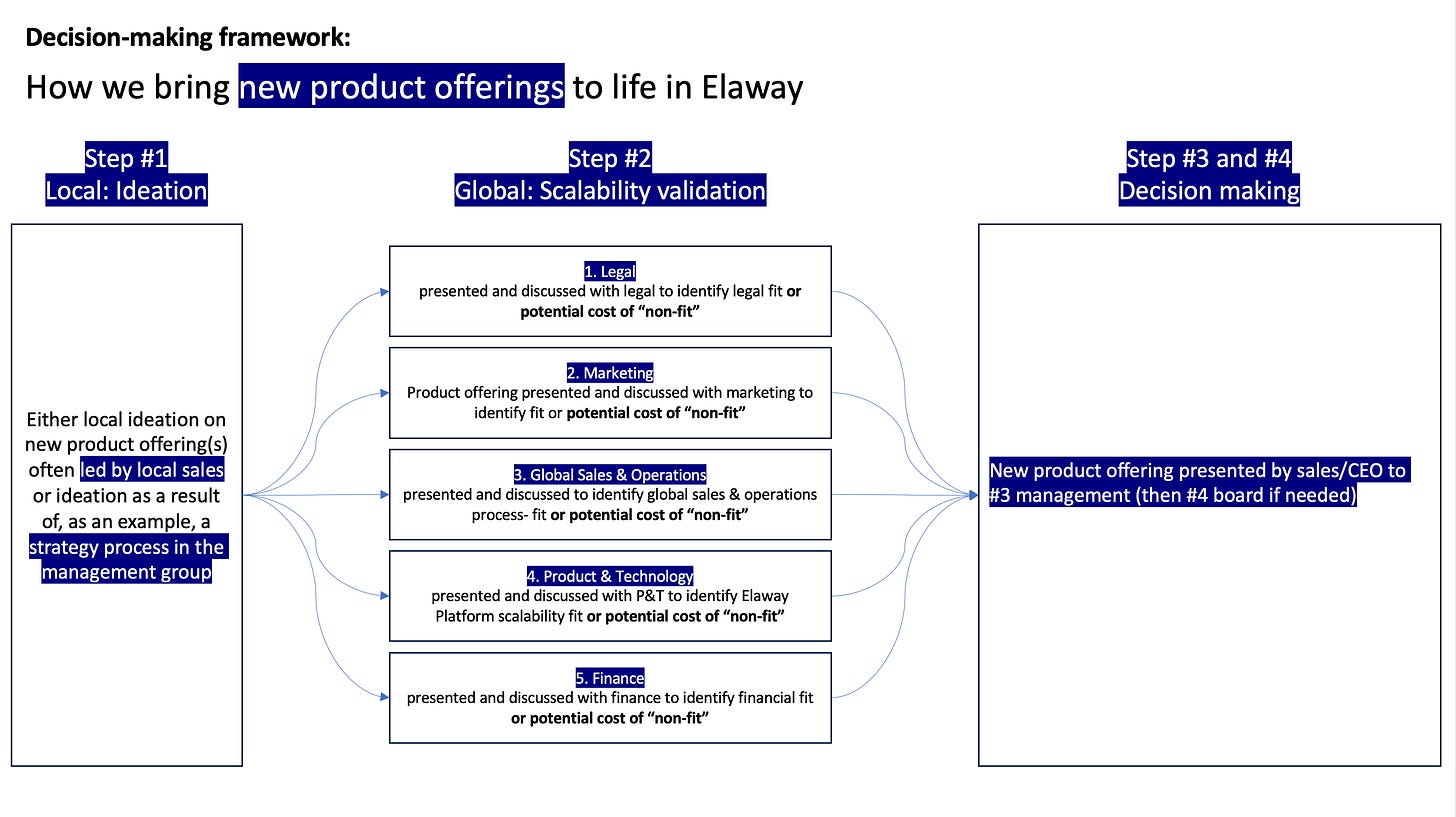Elaway - Our Operating System 2.0 (2023)
Two years after version 1.0, and tripling the size of the company, it's a time for an update on how we organize, plan, measure progress and communicate internally in Elaway in 2023.
Explainer: A company operating system
The main objective behind a company operating system is to free up as much time as possible for management and employees to 'win' while at the same time ensuring that management and employees are working towards the same goals, know why they are working towards those goals, and know how we are progressing towards those goals.
A brief introduction to Elaway.
Elaway works to accelerate electric car adoption by building large-scale charging infrastructure for housing communities in Germany, Sweden, and Norway. After four years of operation, we have built/operate more than 1100 charging facilities, covering nearly 80.000 parking spaces. Currently, Elaway employs close to 80 full-time employees and is growing fast. We have four physical offices (Bergen, Oslo, Stockholm, and Munich) and employees in 9 different locations (some fully remote). Elaway aims to be the number one player in Europe within a couple of years, and we just raised funds to be able to do precisely that.
Executive summary:
Elaway is organized with a global strategy and administration team, a global scaling team (marketing & product & technology), and local volume teams (sales and operations). Summarised, we operate the company as visualized below.
Our way of operating the company is very much inspired by Jim Collins, author of Good to Great, Alan Mulally, former CEO of Ford, and Simen Fure, and Andreas Thorsheim, CPO and CEO of Otovo.
The Elaway Company Operating System
Component 1: Setting the organizational structure
Elaway is divided into three branches—strategy and administration, scale, and volume.
Strategy and administration (global): Responsible for setting the company's direction. What should we offer, and how and where should we make money? Responsible for staying within legal boundaries. Examples of roles in this branch are CEO, CFO, CSO, and CMO.
Scale (global): Responsible for delivering products and systems that scale in all our markets, lower CAC, make sales and operations as efficient as possible, and ensure installers prefer Elaway over our competitors. Examples of roles in this branch are: CPO, CTO, CDO, PMs, TLs, and devs.
Volume (local): Responsible for driving parking space volume growth (sales), installer base growth (operations), and installations (operations) in specific markets. Examples of roles in this branch are: GMs, operations, and sales.
Component 2: Planning
Annually: The management team revises the company's medium-term strategy (2-3 years)
As the base for all decisions in Elaway, we have outlined the long-term company strategy in a company strategy document:
This document outlines where we are, where we want to go, and what we believe is needed to get there.
The document tries to look three years ahead and is updated once a year or more frequently if something fundamental changes.
The document has to be “signed off” by both management and the board to ensure buy-in for the following twelve months.
The document also serves as an onboarding document for new employees, board members, owners, and other potential stakeholders.
Half-yearly: The extended management translates the company strategy into objectives and key results
It is hard, if not impossible, to use the strategy document as a guide day-to-day. That’s why we translate the company strategy document into 12 and 6-month OKRs. OKRs help us translate the strategy document into concrete medium and short-term objectives and attach quantitative key results that help us understand if we are moving towards reaching our objectives.
We use the On One Page tool to summarize long-term vision, medium-term strategy, and all of the OKRs in the company. We start at the top with vision, mission, why, and business model, then annual company-level OKRs, then below that team-level half-year OKRs. The picture below shows the structure. You can read more about the On One Page tool here.
Half-yearly: Breaking OKRs down into roadmap items
The next step for the product and tech department is to look at the company`s OKRs and map out the actions/tasks we need to make short and medium-term to help the company reach its objectives. These actions/tasks are added to our development roadmap.
The product and tech management group revised this development roadmap weekly to ensure we are constantly working on the right things. If any of our stakeholders come to us with a new problem during the six-month OKR period, we use the funnel below to understand whether or not this issue is valuable enough for the company for us to add it to the development roadmap and how to solve it.
Bi-weekly: Development Sprint planning
In Elaway, we use Trello and other similar tools to outline all development tasks that need to be completed within the next two weeks, all tasks that are planned to be completed this current sprint, all tasks that we are working on, and all tasks that are done. You can read more on how we run sprints in Elaway here.
Component 3: Measuring progress
Monthly: KPI reporting to owners
We provide our owners with a comprehensive KPI report each month detailing how different parts of our business are performing. For confidentiality reasons, I cannot give any details of the contents of this report.
Monthly: Business Review
Each month managers of the different global teams and local CEOs meet with the company CEO and CFO to discuss the current situation, cost, progress, et cetera—the pretty standard business review meeting.
Bi-weekly: Performance review meeting
In Elaway, we are pretty proud that when we ask all employees whether or not they understand and know the company`s goals, we are almost entirely “in the green”.
This is important so that we all are pushing in the same direction. One of the main reasons behind this is our bi-weekly performance review with the extended management group (senior and middle management). In this meeting, we read through the whole On One Page, and all teams report their progress on their OKRs. If any OKRs are “in the red,” we break out after the meeting, and all the roles that can contribute towards bringing it “into the green” attend—a random example, not from Elaway below.
Component 4: Decision-making frameworks
For Elaway to win, we need to act fast and give a lot of autonomy to the different teams and roles, but there are some decisions that we need to make together to, for example, make sure we can scale long term. We have built some decision-making frameworks for some of our more essential changes. The example below shows the flow of an idea of a new “product offering” (what we sell) in a local market in Elaway and how we bring that to life.
Component 5: Internal communication
This part outlines how we communicate in practice and ensure all parties are updated.
Annual sustainability report
Starting in 2023. I will report back on how we do this and why. Subscribe to get that post in your inbox when it’s published.
Monthly stakeholder updates
Each month the CEO sends out an update outlining key KPIs, lowlights of last month, highlights of last month, and focus on next month. This update is sent to board members, product advisory board members, and all employees.
Monthly employee all hands
Each month we arrange a digital company all hands. This is a 1.5-hour-long meeting where we review company OKRs, share general information, and share “wins” from the last month. An example of a win is a “new feature launched” or “big sale signed.”
Monthly P&T Demo Day
Each month Product and Tech present new products, features, or upcoming changes to the rest of the company.
Day-to-day: Slack for group-chat, DM & unformal video meetings (huddles)
In version 1.0 of the Elaway Operating System, we used Microsoft Teams for pure legacy reasons. Microsoft Teams are acceptable as a pure chat tool. Still, since we are a company operating in three different markets with four different offices and employees in 9 different locations, the tool we use to communicate internally becomes our de facto headquarter. It’s the only place in the company where everyone is at any one point in time, like a good old-fashioned physical headquarters. The reason for the switch was mainly Slack outperforming Microsoft Teams on
Searchability
Plug-ins
Platform agnosticisty
Fastest in its class, both in tech and UX
Connections and API to partners and services
Huddles (it’s just so good)
Our guidelines for Slack use:
Always assume the best intent. Sometimes tone and context are lost in the text.
Don’t expect an instant response; you should pick up the phone if it’s a critical matter. And feel free to log off Slack to focus. Again, we will call if critical.
Default to posting in public channels. This ensures transparency and knowledge sharing. Only use private groups and DMs for sensitive material or coordinating to avoid spamming public channels.
Treat channels as meeting rooms; feel free to leave if the “meeting” is irrelevant.
Fewer messages mean more efficient collaboration; take time to communicate your message correctly. Write longer messages that scan quickly, and use phrases and bullet points. And try to replace short follow-up messages with emoji reactions. Checkmarks as an example of “read and understood.”
Communicate using threads. In general, your message in Slack should be either:
A new message that your colleagues reply to in a thread
A response to an existing message in the thread below that message.
Make your availability clear. Use status updates to let others know when you are away or when they should expect a delayed response. When you’re not working, consider logging out or setting *Do Not Disturb *so that you can get out of “work mode” and recharge.
Take care when using @mentions. Abide by the conventions for @mentions, particularly when mentioning groups or in large or reserved channels like #announcements and #general (listed at the bottom of this doc).
Day-to-day: Teams for formal video meetings
You would not have a physical meeting in a dark room, looking at yourself in the mirror and at the same time not looking at the one you are addressing in the meeting. It’s interesting, but that is what most of us do in video calls, so we try to implement guidelines for video meetings.
Our guidelines for video meetings:
Turn off self-view. If not, you will pay more attention to yourself than the people you are meeting.
Have the camera in front of you so that you are looking at the people you are meeting with.
Ensure you have adequate lighting in the room where you are sitting and the light source is coming from behind your webcam.
Try to ensure the room you are sitting in is neat and clean, you would not sit in a messy meeting room, and appearances matter in a video call.
If possible, try to ensure your webcam is at face height.
Make sure you have a good-quality mic and webcam.
Every meeting participant logs into the meeting and turns on their webcam, even if in the same room. This is important so those joining remotely understand who is in the meeting and can see and read their expressions.
Component 6: Company policies and compliance
The policies and compliance that need to be in place to operate.
Code of conduct
Procurement Policy.
Data management policy
Gift and Anti-Bribery Policy
Norwegian transparency act
ESG related policies
GDPR
IT and security









Karsten, it is really interesting to see how you build up company operations from scratch in a modern way. Thanks for the insights.